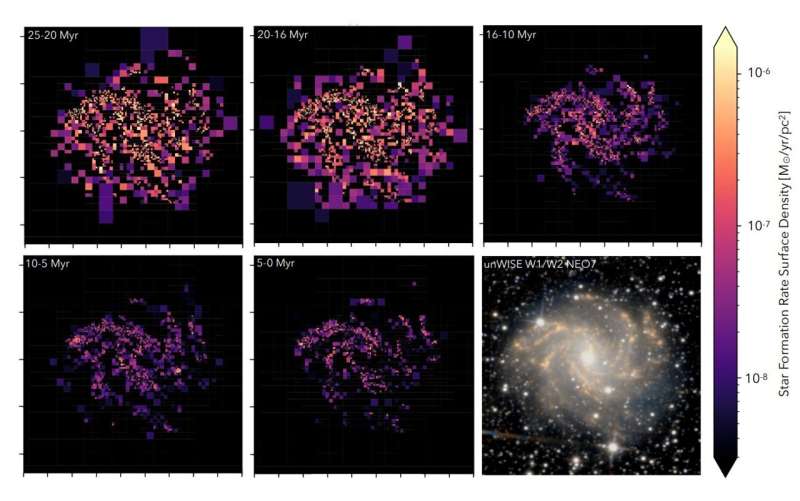July 19, 2023 report
This article has been reviewed according to Science X's editorial process and policies. Editors have highlighted the following attributes while ensuring the content's credibility:
fact-checked
preprint
trusted source
proofread
Astronomers investigate recent star formation history of the Fireworks Galaxy

Astronomers from the University of Washington in Seattle and elsewhere have conducted Hubble Space Telescope (HST) observations of the nearby Fireworks Galaxy. Results of the observational campaign, presented July 10 on the preprint server arXiv, yield crucial insights into the recent star formation history of this galaxy.
Discovered in 1798, the Fireworks Galaxy (also known as NGC 6946) is a nearby face-on star forming spiral galaxy located some 25.5 million light years away. The galaxy has a size of 87,300 light years and its name was coined due to an unusually large number of supernovae observed in it—about ten times more than in the Milky Way.
Although many studies of the Fireworks Galaxy have been conducted to date, its star formation rate (SFR) is not well constrained, estimated to be between three and 12 solar masses per year. This discrepancy is mainly due to the diverse methods of measuring star formation rate and the wide range of different distances used.
A team of astronomers led by Debby Tran has performed HST observations of the Fireworks Galaxy, with the main goal of determining its SFR and to better understand its star formation history.
"We analyze its resolved near-ultraviolet (NUV) stellar photometry measured from images taken with the Hubble Space Telescope's (HST) Wide Field Camera 3 (WFC3) with F275W and F336W filters. We model the color-magnitude diagrams (CMD) of the UV photometry to derive the spatially-resolved star formation history (SFH) of NGC 6946 over the last 25 Myr," the researchers wrote in the paper.
The HST data allowed Tran's team to produce maps of the spatial distribution of young stellar populations and measure the total recent SFR of nearly the entire young stellar disk. The study was complemented by data from ESA's Gaia satellite.
All in all, the researchers found that the global SFR for the Fireworks Galaxy over the last 25 million years was approximately 13.16 solar masses per year. The SFR was even at a level of 23.38 solar masses per year 16 to 25 million years ago and afterward it monotonically decreased between 10 and 16 million years ago, reaching a steady SFR of 5.31 solar masses per year in the last 10 million years.
The observations also found that the two areas of the Fireworks Galaxy exhibiting high star-forming activity—one HII region (region of ionized atomic hydrogen) located at the tip of the galaxy's northeast spiral arm and the so-called Hodge Complex (a super star cluster containing multiple young star clusters)—contain a higher amount of recent star formation than expected for regions of their size. The astronomers noted that the Hodge Complex showcases more recent star formation relative to the declining global star formation.
More information: Debby Tran et al, Spatially-Resolved Recent Star Formation History in NGC 6946, arXiv (2023). DOI: 10.48550/arxiv.2307.04853
Journal information: arXiv
© 2023 Science X Network





















